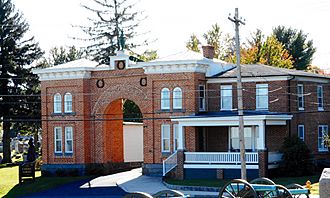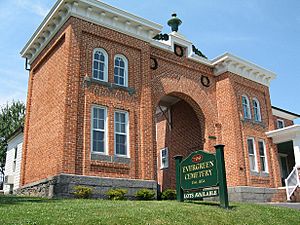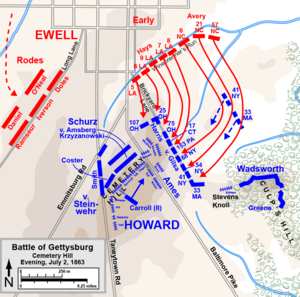Evergreen Cemetery gatehouse facts for kids
Quick facts for kids Evergreen Cemetery gatehouse |
|
|---|---|
 |
|
| General information | |
| Type | historic district contributing structure |
| Architectural style | Italianate |
| Location | 799 Baltimore Pike |
| Country | United States |
| Coordinates | 39°49′15″N 77°13′46″W / 39.82076°N 77.22935°W |
| Opened | September 1, 1855 |
| Technical details | |
| Material | brick |
| Design and construction | |
| Architect | Stephen Decatur Button |
The Evergreen Cemetery gatehouse is a very old and important building built in 1855. You can find it at 799 Baltimore Pike in Adams County, Pennsylvania. This gatehouse played a big part in the American Civil War, especially during the famous Battle of Gettysburg from July 1 to 3, 1863. It's considered a special part of the Gettysburg Battlefield Historic District.
Contents
The Gatehouse's Story
Evergreen Cemetery's Beginning
The Evergreen Cemetery is located on a hill just south of Gettysburg. It sits between Baltimore Pike and Tanneytown Road. The Ever Green Cemetery Association of Gettysburg was officially started in 1853. It is still a private cemetery today, meaning it's not run by the government.
A famous architect from Philadelphia named Stephen Decatur Button designed the gatehouse in 1855. The first stone of the building was laid on September 1 by Reverend Samuel Simon Schmucker. Local builders, George and Henry Chritzman, constructed the brick building very quickly. It took them less than three months to finish it. The cost was $1,025, which was a lot of money back then! The gatehouse was used as the cemetery's office. It was also the home for the person who took care of the cemetery.
Role in the Battle of Gettysburg
During the American Civil War, the cemetery's high ground was very important. Major-General Oliver Otis Howard realized this. He placed his cannons along what became known as "Cemetery Hill." These cannons faced north and west. On the other side of Baltimore Pike, his cannons faced north and east. General Howard made the cemetery's gatehouse his headquarters for the XI Corps (Union Army). He stayed in the building for all three days of the battle.
On July 1, the town of Gettysburg was evacuated. The telegraph key from the Gettysburg Railroad Station was moved near the gatehouse. This helped keep communications open during the battle. That night, Elizabeth Thorn, whose husband was the cemetery caretaker, cooked a special dinner. She prepared it for General Howard, General Sickles, and General Slocum.
At dusk on July 2, a big fight happened. Five Louisiana regiments and three North Carolina regiments attacked the Union cannons. This was called the Battle of East Cemetery Hill. They charged from the east. A historian named Frederick Hawthorne wrote about how General Howard successfully defended the area. He said that Union soldiers "rushed out through the cemetery gateway to help drive the Confederates away."
After the Battle
The Evergreen Cemetery gatehouse survived the Battle of Gettysburg. After the battle, Elizabeth Thorn, the caretaker's wife, buried about one hundred fallen soldiers nearby. The building needed some repairs, which were done in 1885. At that time, a new part called the "lodge" was added to the gatehouse.
In 1972, the "Evergreen Cemetery archway house" was recognized as a special historic building. The Gettysburg Borough Council gave it this important title. It was one of 38 buildings outside the main town to receive this honor.
Images for kids







